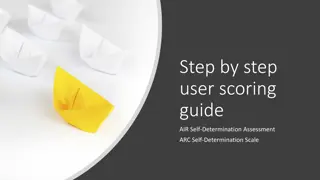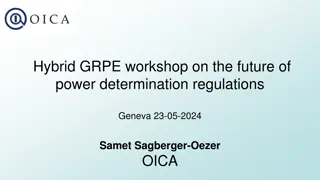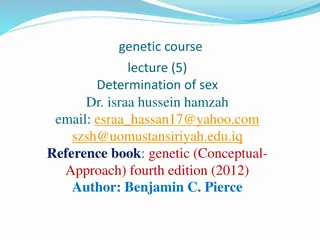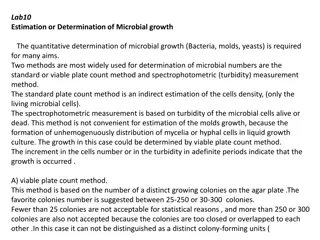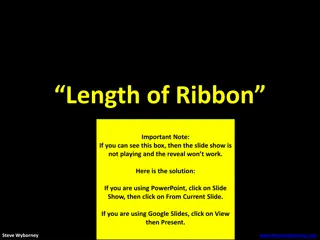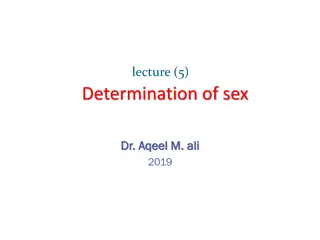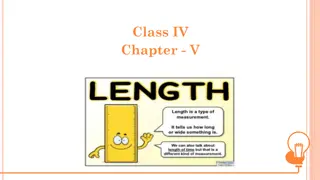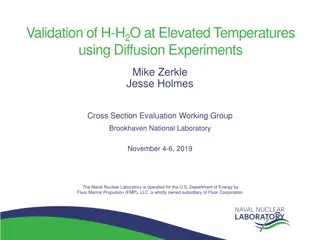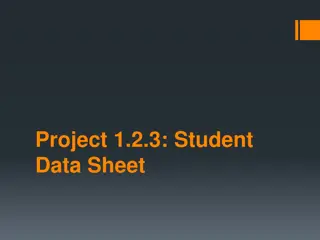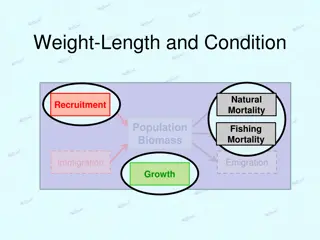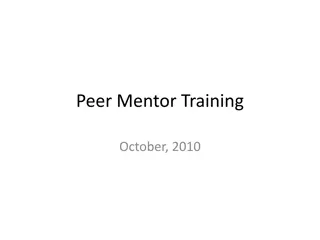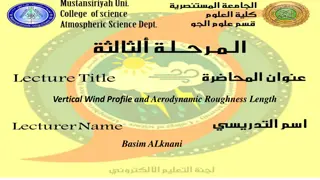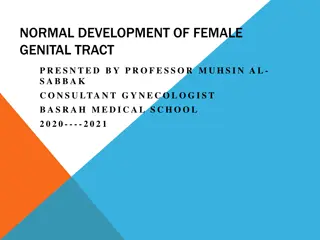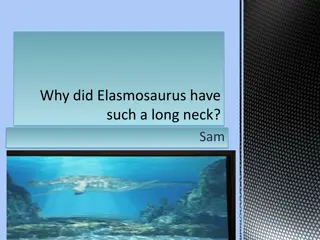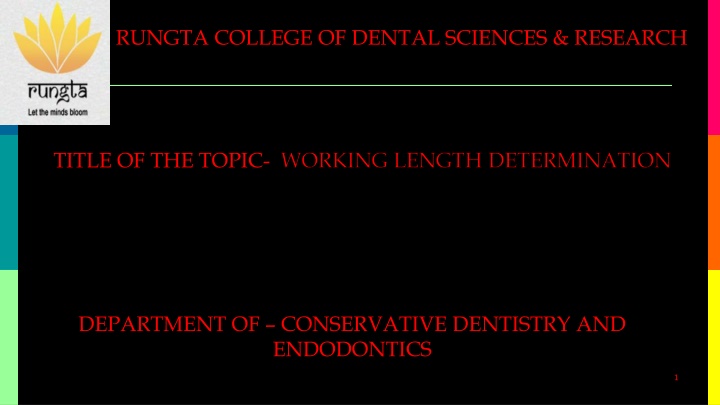
Determination Methods for Working Length in Endodontics
Learn about the various methods used for determining the working length in conservative dentistry and endodontics, including radiographic, Grossman's method, and formula-based approaches. Gain insights into Anatomic considerations, Terminologies, and Accuracy of Apex Locators. Enhance your knowledge in this crucial aspect of dental practice to ensure successful outcomes.
Download Presentation

Please find below an Image/Link to download the presentation.
The content on the website is provided AS IS for your information and personal use only. It may not be sold, licensed, or shared on other websites without obtaining consent from the author. If you encounter any issues during the download, it is possible that the publisher has removed the file from their server.
You are allowed to download the files provided on this website for personal or commercial use, subject to the condition that they are used lawfully. All files are the property of their respective owners.
The content on the website is provided AS IS for your information and personal use only. It may not be sold, licensed, or shared on other websites without obtaining consent from the author.
E N D
Presentation Transcript
RUNGTA COLLEGE OF DENTAL SCIENCES & RESEARCH TITLE OF THE TOPIC- DEPARTMENT OF CONSERVATIVE DENTISTRY AND ENDODONTICS 1
Specific learning Objectives At the end of this presentation the learner is expected to know ; Core areas* Domain ** Category # Introduction Cognitive Must know Method Psychomotor Must know Armamentarium Cognitive Must know *Subtopic of importance ** Cognitive, Psychomotor or Affective # Must know , Nice to know & Desire to know ( Table to be prepared as per the above 2
CONTENTS Anatomic considerations & Terminologies used Determination of Working Length by Digital Tactile Sense Determination of Working Length by Apical Periodontal Sensitivity Determination of Working Length by Paper Point Measurement Determination of Working Length by Radiographic methods Grossman s method Ingle s method Weine s method Classification and Accuracy of Apex Locators
Determination of Working Length by Radiographic methods the method of choice for determination of working length The techniques and calculations - more or less vary - but the basic procedure of taking radiographs of the tooth with a radiopaque instrument extending into the canal - same 4
Grossmans method Grossman: Rule of proportion CLT = KLI ALT / ALI Where, CLT= correct length of the tooth KLI= known length of the instrument in the tooth ALT= apparent length of the tooth on radiograph ALI= apparent length of the instrument on radiograph 5
A, The length of the tooth is measured on the diagnostic radiograph (schematic view). B, This measurement is transferred to a diagnostic instrument prepared with a silicone stop, the instrument is placed in the root canal, and a radiograph is made. C and D, The root canal and working lengths are determined from the radiograph. 6
Other formula based methods Bregman (1950) devised a method 25 mm length flat probes having a steel blade fixed with acrylic resin as a stop leaving a free end of 10mm for placement into the root canal. This probe is placed in the tooth until the metallic end touches the coronal reference point. A radiograph is taken The length is calculated from following formula: Real instrument Length Apparent length of tooth Actual length of the tooth = Apparent Instrument Length 7
Ingles method The following items are essential to perform this procedure: 1.Good, undistorted, preoperative radiographs showing the total length and all roots of the involved tooth. 2.Adequate coronal access to all canals. 3.An endodontic millimeter ruler. 4.Working knowledge of the average length of all of the teeth. 5.A definite, repeatable plane of reference to an anatomic landmark on the tooth, a fact that should be noted on the patient s record. 8
Method 1. Measure the tooth on the preoperative radiograph 2. Subtract at least 1.0 mm safety allowance for possible image distortion or magnification. 3. Set the endodontic ruler at this tentative working length and adjust the stop on the instrument at that level 4. Place the instrument in the canal until the stop is at the plane of reference unless pain is felt (if anesthesia has not been used), in which case, the instrument is left at that level and the rubber stop readjusted to this new point of reference. 9
5. Expose, develop, and clear the radiograph 6. On the radiograph, measure the difference between the end of the instrument and the end of the root and add this amount to the original measured length the instrument extended into the tooth. If, through some oversight, the exploring instrument has gone beyond the apex, subtract this difference 7. From this adjusted length of tooth, subtract a 1.0 mm safety factor to conform with the apical termination of the root canal at the apical constriction 8. Set the endodontic ruler at this new corrected length and readjust the stop on the exploring instrument 10
9. Because of the possibility of radiographic distortion, sharply curving roots, and operator measuring error, a confirmatory radiograph of the adjusted length is highly desirable. 10.When the length of the tooth has been accurately confirmed, reset the endodontic ruler at this measurement. 11. Record this final working length and the coronal point of reference on the patient s record. 12. Once again, it is important to emphasize that the final working length may shorten by as much as 1 mm as a curved canal is straightened out by instrumentation. It is therefore recommended that the length of the tooth in a curved canal be reconfirmed after instrumentation is completed. 12
Weines modification - If, radiographically, there is no resorption of the root end or bone, shorten the length by the standard 1.0 mm. If periapical bone resorption is apparent, shorten by 1.5 mm, and if both root and bone resorption are apparent, shorten by 2.0 mm The reasoning - If there is root resorption, the apical constriction is probably destroyed hence the shorter move back up the canal. Also, when bone resorption is apparent, there probably is also root resorption, even though it may not be apparent radiographically. 13
Weines Method (based on Kuttler s studies) The basis for this method s value are the measurements provided by Kuttler relating to the distance between the major & minor diameters. In younger patients, the distance between these two positions approx. 0.5 mm In older patients, due to increased buildup of cementum, the distance approx. 0.67 mm The method given by F Weine based on Kuttler s measurements is as follows - 15
Before starting endo. t/t analyze C-L-E-W Identify the probable canal Configuration and any common variants The estimated Lengths of the root(s) The site of Exiting the canal(s) The estimated Width of the canal(s) C-L-E-W - by analyzing the pre-operative radiographs straight (for site of exit, root length, canal width) and angled views (for canal configuration, site of exit, no. of roots and canals) 16
Stepwise technique Prepare correct access cavity using the information from the straight and angled radiographs. Remove whatever pulp tissue or debris that one believe should be removed 1. 2. Locate major diameter or minor diameter on the pre-operative radiograph 17
3. Estimate the length of the root(s), by measuring the length with a millimeter ruler on the preoperative radiographs (without projection, but may use magnification) 4. Estimate the width of the canal(s) on the radiographs. Choose an appropriate fitting file. 18
6. If the file appears too long or too short by more than 1 mm from minor diameter, make the interpolation (correction), adjust the file accordingly, and retake the film to verify aacuracy. 7. If the file appears too long or too short by less than 1 mm from minor diameter, make the interpolation (coorection) and use that as the calculated WL 8. If file reaches the major diameter exactly, subtract 0.5 mm from that length if the patient is 35 years old or younger or 0.67 mm from that length if the patient is older. If the file reaches the site that you believe is exactly at the minor diameter, use that as the calculated working length. 19
Use of radiographic apex as Termination point ? Weine - aspects of use of radiographic apex as Termination point. He discussed there still remain a number of excellent clinicians proponents. E.g. graduates of the endodontic program at Boston University and their disciples are most active proponents of this technique. Concept it is impossible to locate the CDJ clinically, and the radiographic apex is the only reproducible site available 20
Calculate the length of the tooth to the radiographic apex keep this distance patent use larger file a bit shorter most ideal preparation developed as stated Decrease in success rate, postoperative pain, undesirable tear drop shape prepared at apex amenable to seal 21
Advantages of radiographs It is an accurate road map between access opening and apex provided - proper angulation & technique are employed and interpreted correctly Easy to use The use of high speed films and automatic processing techniques also lessened the time required 22
Disadvantages of radiographs Radiation hazards patients as well as operator Probably time consuming Loss of bucco-lingual details If rubber dam in place taking radiograph becomes difficult Gag reflex Observer bias 23
Expanded radiographic paradigms for Determination of Working Length Xeroradiography Digital image processing Radiovisiography 24
TAKE HOME MESSEGE/ FOR THE TOPIC COVERED (SUMMARY) The CDJ or minor diameter is a practical and anatomic termination point for the preparation and obturation of the root canal and this cannot be determined radiographically Modern apex locators can determine this position with accuracies greater than 90% but with some limitations No individual method is truly satisfactory in determining endodontic working length 25
Therefore, combination of methods should be used to assess the accurate working length determination Knowledge of apical anatomy, prudent use of radiographs and correct use of electronic apex locator will assist practitioners to achieve predictable results 26
Question & Answer Session 1. Determination of working length by Weine s method. 2. Write about determination of Working Length by Grossman method 3. Determination of Working Length by Ingle s method 27
References Textbooks 1. Ingle JI, Bakland LK: Endodontics, 5th ed. 2. Grossman LI & others: Endodontic Practice, 11th ed. 3. Weine FS: Endodontic Therapy, 6th ed. 4. Walton RE, Torabinajed M: Principles and Practice of Endodontics 5. Chandra S & Chandra S: Textbook of Endodontics 6. Pitt Ford TR: Harty s Endodontics in Clinical Practice, 4th ed. 28
Thank You !! 29

